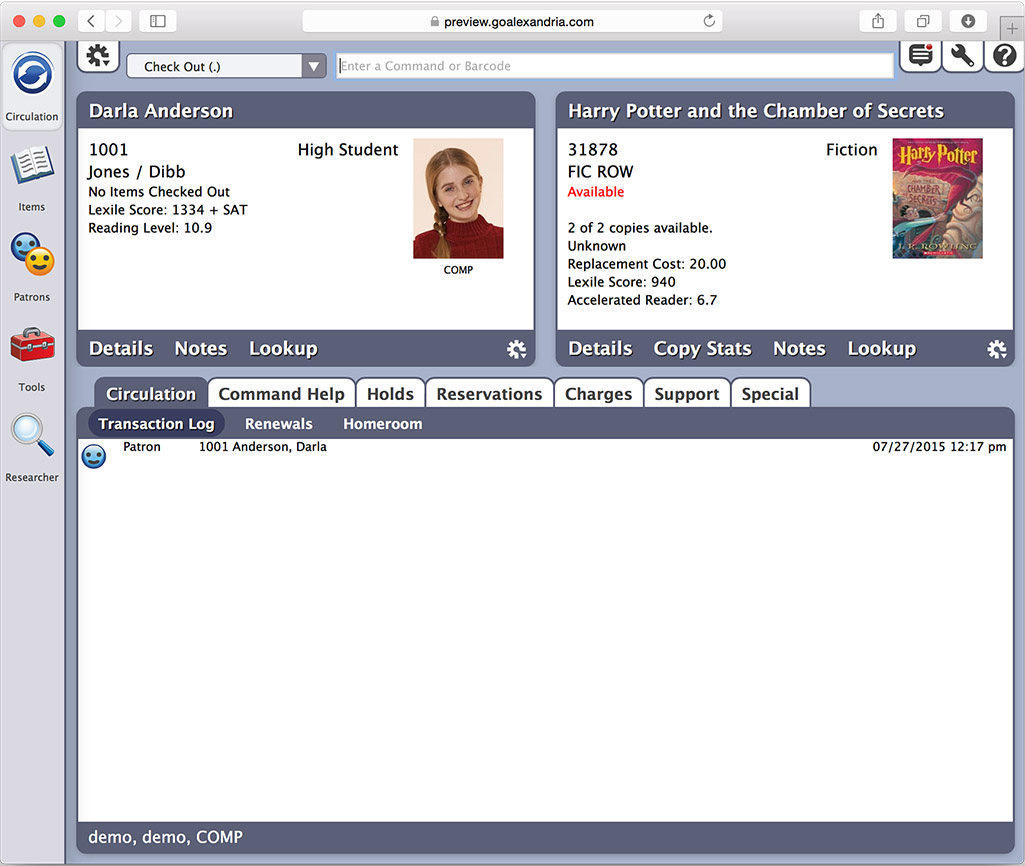
Alexandria Librarian
With Alexandria v7, our main goal was to move to a fully cloud
based solution. At the time, Apple was pushing SproutCore as their web application framaework of choice. So
the project was not only moving from an on site server / client solution, it was also moving technologies on
the front end.
Alexandria v6 had been in use for a few years and it was released with more than a few major flaws. Librarians
in general are very reluctant to update their application, especially during the school year. With that and a
history of rocky updates and we knew v7 had to knock it out of the park or it could be the last straw.
One major issue during roll out can taint your user base. Trust is earned in drops and lost in buckets.
Rooting Out the Real Issues
To kick off the project I spent a week meeting with the Support
team interviewing team members and reviewing their call history. I wasn't able to get a complete picture of
the user's pain points, but it was a good start. I also worked with the support team to find a handful of
users that were willing to meet with me to discuss their current pain points.
These meetings were extremely beneficial on multiple fronts. Not only was I able to discover some undiscovered
issues with the application, these meetings also helped allieviate some of the customer's frustration. The few
hours the users spent with me gave them a sense of ownership and pride in knowing they were directly involved
in improving the application. All but one of these customers became regular testers in my future user testing
sessions.
I now had a relatively clear picture of the user's pain points as well as their goals with the application. I
now turned my focus to the stakeholders. Along with understanding the user's side, I also needed to understand
what the company wanted to accomplish with the new application. The sales team had a list of features that
they believed would assist them in selling the product. Their extensive research of the market and our
competitors was vital to the success of Alexandria v7.

When a workaround becomes the norm, pain points can be forgotten. Discovering these hidden pain points may require clever questioning or direct observation.
Designing a Solution
Getting together with my team, we spent two days reviewing data
and defining the heirarchy of pain points. This list would shape the skeleton of Alexandria v7. From
the beginning we knew the application had to support iPads and touch nagivation. A major selling point of the
application was that Librarians would no longer be tied to the circulation desk.
The main layout of the librarian screen had to retain a few aspects of the previous design. The screen needed
a Patron frame in the upper left and an Item frame in the upper right. This main layout has been consistent
with the application since version one. None of our data suggested this basic layout should be modified. The
content of these Patron and Item frames needed to be redesigned. Crafting quick and easy navigation from this
screen was paramount.
Ideas were detailed on whiteboards and refined throughout this process. Stakeholders were brought in to make
sure their needs were met with the new design. I then moved the designs from whiteboard to low fidelity
wireframes to prepare for testing.

Ensuring a shared understanding of the design solution will reduce errors and the effort required for development.
The User Testing Cycle
Utilizing the existing group of beta testers as well as the new
group from my discovery phase, I began holding user testing sessions. Initial tests were held in a group
format, but I quickly realized that a few testers were dominating the sessions and it needed to be split up
into one on one sessions.
As the product solidified through these sessions, I created more detailed prototypes to refine the entire
journey through the application. Each user testing session was moderated and recorded. These recordings were
reviewed with the team and any details I missed were documented and addressed.
I refined the solution to a minimum viable product and created a backlog of features that would drive the
progression of the application for the next year. Utilizing Sketch, Invision, and Zeplin to ensure a complete
understanding of the design with the Dev team and QA cut months off the development timeline.

Designing an application requires participation of each branch of the company. The goal should be to remove as many assumptions as possible early in the process.
v7 Development and Release
During the development process, any issues found with
implementing the design were quickly addressed. Dev and QA feedback was used to further refine the solution.
Once development on the MVP was complete, the application was sent to the beta testing team for a two week
live test. Further refinement was completed during this time until the product was deemed ready for
release.
The new v7 release was initially rolled out to a small group of the cloud customers. This initial release was
extremely well received and, once a fiew minor issues were fixed, was released to the entire hosted user base.
Over the next few months, the update spread to the non hosted customers and was also very well received.
Alexandria v7 is still the current version in use today. Many updates have been made to the application, but
the core layout and flow remains the same. The amount of effort and user testing that went into the early
design of the product was evident in the feedback and sales numbers. This was the first project where I felt
extremely comfortable and confident in my abilities as a Senior Product Designer.